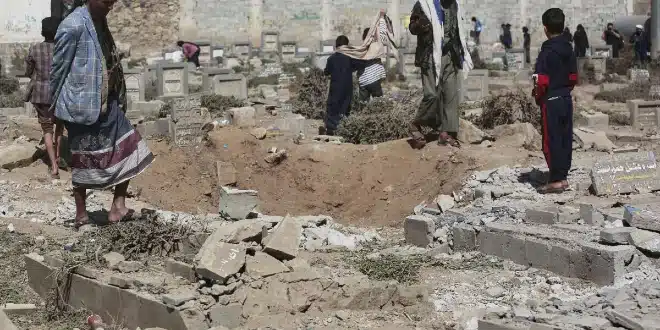Airstrikes carried out by the United States on Yemen’s capital, Sanaa, have resulted in the deaths of at least 12 individuals and left 30 others wounded, according to statements released by Houthi officials early Monday. The strikes, which reportedly targeted a market in the Farwa neighborhood of the Shuub district, are part of a broader escalation in U.S. military actions against the Iran-aligned rebel group.
Footage from the aftermath showed considerable destruction—damaged buildings, burning vehicles, and chaotic scenes as civilians rushed to aid victims, including children. The images, broadcast by the Houthi-run al-Masirah television network, showed injured residents being carried on stretchers and scenes of panic in local hospitals.
In addition to the strikes on Sanaa, the U.S. also launched attacks on multiple other regions across Yemen overnight, including Amran, Hodeida, Marib, and Saada. These areas have previously been subjected to military action due to suspected militant activity.
Strategic Objectives and Rising Tensions
The latest series of strikes follows a deadly U.S. operation last week that hit the Ras Isa fuel terminal, where over 70 people were reported killed and more than 170 injured. These military operations form part of Washington’s intensified campaign against the Houthis, triggered by the group’s ongoing assaults on international shipping routes and missile launches aimed at Israel.
The Houthis, regarded as the final operational arm of Iran’s self-declared “Axis of Resistance” capable of striking Israel, have maintained that their attacks are acts of solidarity with Palestinians, especially in light of Israel’s blockade on aid entering Gaza.
From late 2023 through early 2025, the Houthis were responsible for over 100 attacks on merchant vessels traversing the Red Sea, causing significant disruption to one of the world’s most important trade corridors. Two ships were sunk during this period, and four crew members lost their lives. The assaults have forced many vessels to reroute, affecting nearly $1 trillion in annual global trade.
The latest round of U.S. airstrikes comes amid renewed negotiations between Washington and Tehran in Rome regarding Iran’s nuclear ambitions. Analysts believe the ongoing discussions are indirectly influencing U.S. military posture in the region, as the White House attempts to apply pressure on Iran-backed proxies without escalating into broader conflict.


